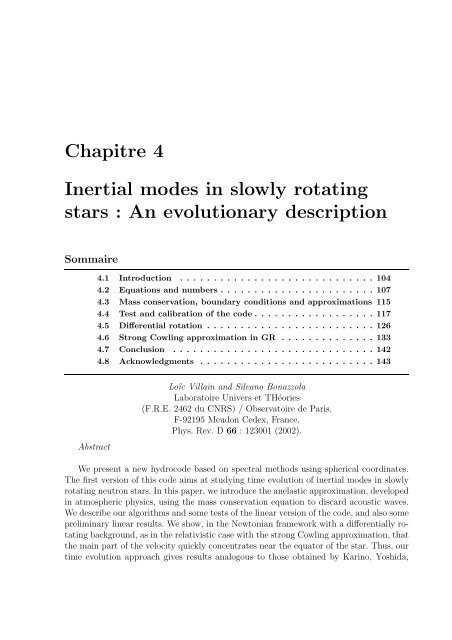Ecole doctorale de Physique de la région Parisienne (ED107)
Ecole doctorale de Physique de la région Parisienne (ED107)
Ecole doctorale de Physique de la région Parisienne (ED107)
Create successful ePaper yourself
Turn your PDF publications into a flip-book with our unique Google optimized e-Paper software.
Chapitre 4<br />
Inertial mo<strong>de</strong>s in slowly rotating<br />
stars : An evolutionary <strong>de</strong>scription<br />
Sommaire<br />
Abstract<br />
4.1 Introduction . . . . . . . . . . . . . . . . . . . . . . . . . . . . . 104<br />
4.2 Equations and numbers . . . . . . . . . . . . . . . . . . . . . . . 107<br />
4.3 Mass conservation, boundary conditions and approximations 115<br />
4.4 Test and calibration of the co<strong>de</strong> . . . . . . . . . . . . . . . . . . 117<br />
4.5 Differential rotation . . . . . . . . . . . . . . . . . . . . . . . . . 126<br />
4.6 Strong Cowling approximation in GR . . . . . . . . . . . . . . 133<br />
4.7 Conclusion . . . . . . . . . . . . . . . . . . . . . . . . . . . . . . 142<br />
4.8 Acknowledgments . . . . . . . . . . . . . . . . . . . . . . . . . . 143<br />
Loïc Vil<strong>la</strong>in and Silvano Bonazzo<strong>la</strong><br />
Laboratoire Univers et THéories<br />
(F.R.E. 2462 du CNRS) / Observatoire <strong>de</strong> Paris,<br />
F-92195 Meudon Ce<strong>de</strong>x, France.<br />
Phys. Rev. D 66 : 123001 (2002).<br />
We present a new hydroco<strong>de</strong> based on spectral methods using spherical coordinates.<br />
The first version of this co<strong>de</strong> aims at studying time evolution of inertial mo<strong>de</strong>s in slowly<br />
rotating neutron stars. In this paper, we introduce the ane<strong>la</strong>stic approximation, <strong>de</strong>veloped<br />
in atmospheric physics, using the mass conservation equation to discard acoustic waves.<br />
We <strong>de</strong>scribe our algorithms and some tests of the linear version of the co<strong>de</strong>, and also some<br />
preliminary linear results. We show, in the Newtonian framework with a differentially rotating<br />
background, as in the re<strong>la</strong>tivistic case with the strong Cowling approximation, that<br />
the main part of the velocity quickly concentrates near the equator of the star. Thus, our<br />
time evolution approach gives results analogous to those obtained by Karino, Yoshida,
















